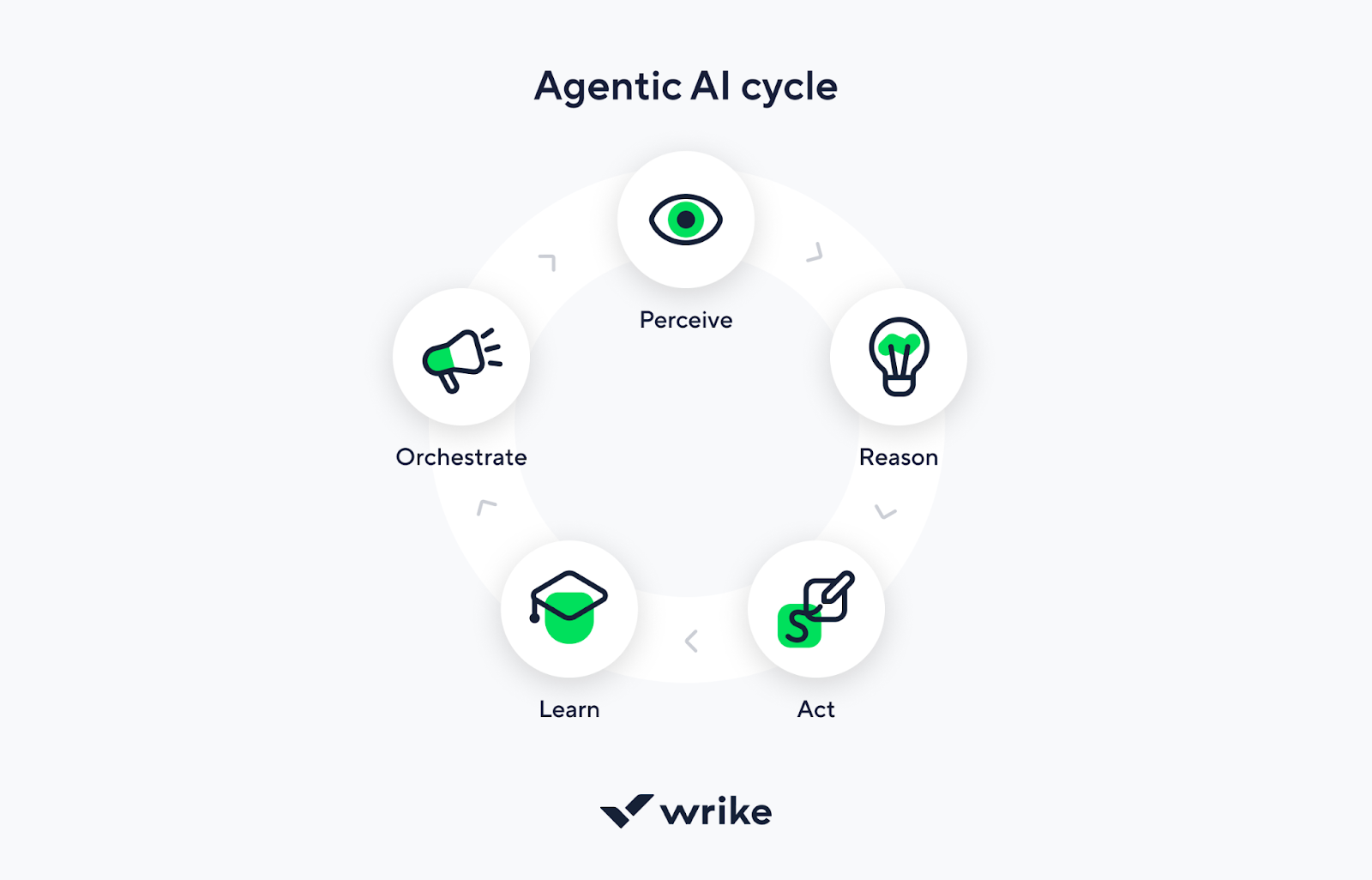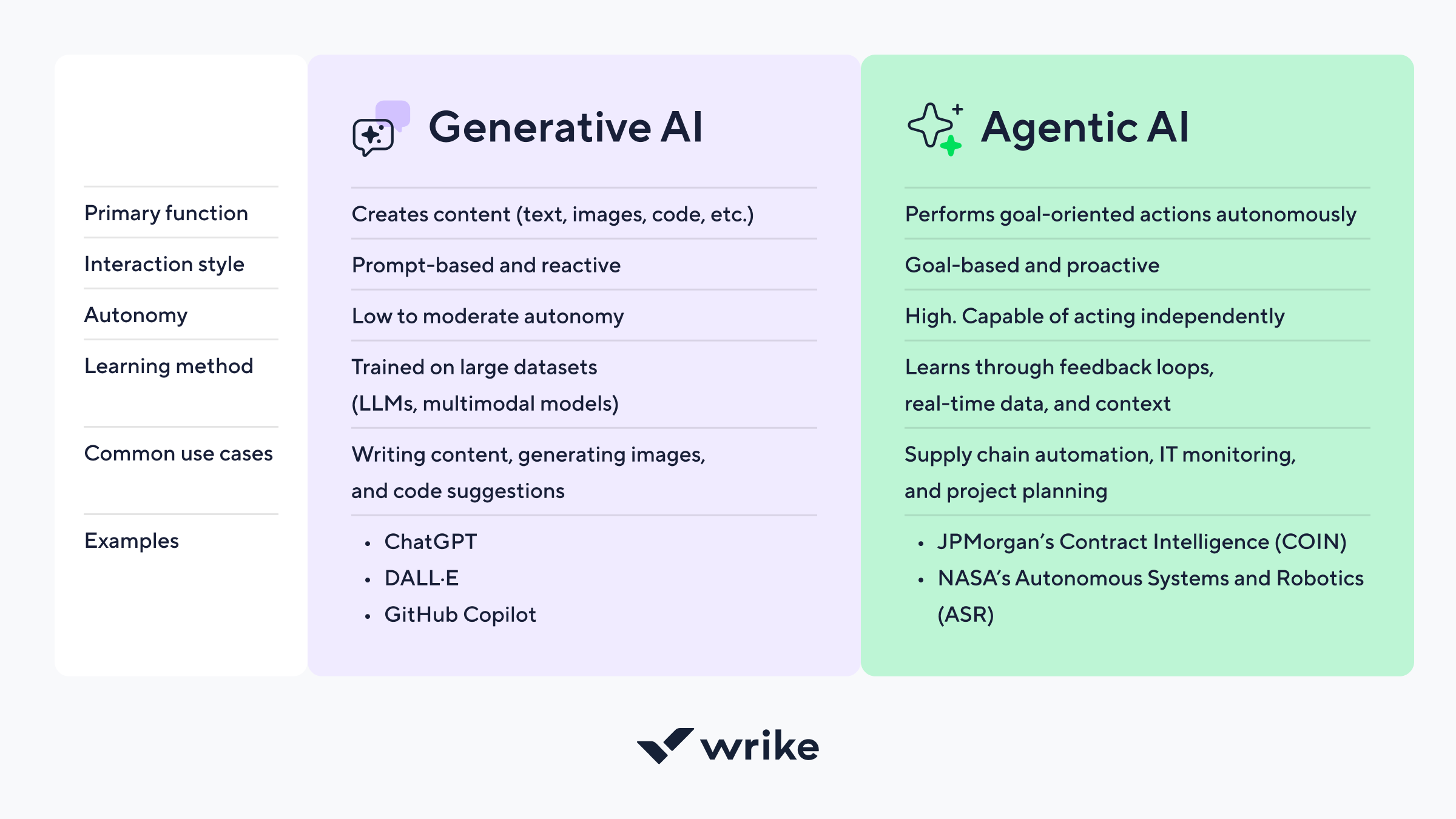Key takeaways:
- What distinguishes agentic AI from generative AI? Agentic AI autonomously executes goal-oriented tasks, while generative AI creates content based on user prompts.
- How do generative AI systems learn? They learn from large datasets to understand patterns and produce outputs like text and images.
- What are the key features of agentic AI? Agentic AI features include autonomy, real-time adaptability, decision making, and multi-agent collaboration.
- In what scenarios is agentic AI most beneficial? It's ideal for complex, adaptive tasks requiring independent action, such as project management and supply chain optimization.
- Can agentic AI and generative AI work together? Yes, they can integrate to connect insights generated by AI with actionable steps in workflows.
AI tools are everywhere, but not all are created equal. As enterprise teams race to adopt the latest innovations, a clear question is emerging: What's the difference between generative AI and agentic AI, and which one actually moves work forward?
If you're leading projects or teams, knowing the difference isn't just a nice-to-have — it's how you make smarter, faster calls.
Generative AI is known for its creative power, able to produce text, images, and ideas at scale. But what if the goal is to execute tasks or connect multiple workflows? That's where agentic AI comes in. With greater AI capabilities for autonomy, reasoning, and decision making, agentic systems are built to act.
If you've ever wondered whether you need to choose between these two AI types, or if they can work together to deliver even more impact, this breakdown is for you.
We'll unpack their strengths, show how they differ in action, and help you decide how each fits into your digital strategy.
What is agentic AI?
Agentic AI is a new class of intelligent systems built to make decisions, adapt in real time, and take action without needing constant human oversight. These systems perceive their environment, make decisions, and execute actions based on a defined goal.
Think of agentic AI as a highly capable team member. It can handle complex scenarios and learn over time using techniques like reinforcement learning — the same method used to train systems like AlphaGo.
That means every interaction, outcome, or piece of feedback helps it get better at completing its tasks.
What makes agentic AI especially useful for enterprise teams is that it's built to act independently on strategic tasks, not just operational ones.
For example, an agentic AI system could monitor supply chain delays, reassign vendor priorities, and update project timelines, all without manual intervention. This shift from reaction to proactive execution is what sets agentic AI apart in a business context.
How it works
Agentic AI systems function through a continuous loop of perception, reasoning, and action, all driven by AI agents.
Agentic AI can:
- Shift project timelines
- Manage financial portfolios
- Optimize supply chains
- Enhance customer service interactions
- Adjust schedules
The brain behind this operation is the Model Context Protocol (MCP) — a standardized framework that connects AI agents to the tools, data, and systems they need in real time.
MCP allows agentic AI to orchestrate workflows across platforms, making decisions based on current conditions instead of static training data.
How does it differ from traditional AI?
Traditional AI systems, including many generative AI tools, are reactive. They require specific prompts or inputs and operate within clearly defined parameters. While powerful for generating content or surfacing insights, these systems typically don't act unless directed.
Agentic AI is different. It's designed to initiate action, not just respond. It uses reinforcement learning to improve its performance over time, evaluates context to make decisions, and can coordinate across tools and teams.
| Feature | Traditional AI | Agentic AI |
| Autonomy | Requires human prompts or fixed rules | Operates independently with minimal human input |
| Decision making | Follows preprogrammed logic | Contextual, goal-based reasoning using live data |
| Adaptability | Limited to training data or static rules | Learns from outcomes and adjusts behavior over time |
| Workflow role | Supports specific tasks (e.g., tagging, predictions) | Executes and orchestrates multistep workflows |
| Use cases | Data classification, email filters, and simple chatbots | Resource reallocation, project planning, and automated coordination |
| Collaboration ability | Works in isolation | Collaborates with other agents in multi-agent systems |
| Responsiveness | Reactive | Proactive |
Because agentic AI operates with minimal human input, it's well-suited for managing complex tasks and strategic initiatives that require constant adaptation.
For example, while a generative AI model might help write a report, an agentic AI system could detect a stalled project, reassign team members, pull data from multiple systems, and notify stakeholders without being prompted.
What is generative AI?
Generative AI, or GenAI, refers to a class of AI tools designed to create new content based on patterns learned from massive datasets. These systems rely on powerful models known as large language models (LLMs), which are trained on everything from books and code to websites and customer interactions.
If you've ever used ChatGPT to brainstorm or asked a tool to draft a slide deck or generate marketing visuals, you've used generative AI. These tools are built to be responsive — they take your input and produce a polished output in return.
GenAI's ability to accelerate content-heavy workflows makes it especially appealing to teams. Marketing teams use GenAI to draft campaigns faster, developers lean on it for boilerplate code, and support teams rely on it to auto-suggest customer responses.
However, while it's powerful, GenAI typically doesn't take independent action. It's designed to assist rather than act.
How it works
GenAI works by turning training data into something new. Powered by LLMs, it processes billions of data points — documents, images, code, and more — to learn patterns, structures, and context.
These systems are especially good at content creation, thanks to their built-in natural language processing (NLP) and natural language understanding capabilities. This allows them to interpret prompts conversationally and respond in a way that feels intuitive, making them particularly good at coordinating creative tasks or communicating 1:1.
GenAI can create:
- Text
- Images and video
- Sound, speech, and music
- Software code
- Design and art
- Simulations and synthetic data
But GenAI is reactive by nature. It doesn't initiate decisions or execute actions on its own. Instead, it waits for direction from a user and then produces content accordingly.
How does it differ from traditional AI?
Traditional AI systems are limited by predefined rules and narrow task scopes. They typically require structured inputs and follow set instructions — think of tools that filter spam, auto-tag images, or calculate risk scores.
These systems aren't designed to adapt or generate anything new; they follow logic trees and execute one path at a time.
GenAI, on the other hand, can create something new. It can produce entirely new content, from blog posts and product descriptions to data visualizations and code. Because these systems can generate outputs from a variety of user inputs, they have become essential in modern AI applications.
| Feature | Traditional AI | Agentic AI |
| Autonomy | Requires human prompts or fixed rules | Generates content based on user inputs and model patterns |
| Decision making | Follows preprogrammed logic | Produces outputs based on patterns in training data |
| Adaptability | Limited to training data or static algorithms | Learns and improves through fine-tuning and user feedback |
| Workflow role | Handles narrow tasks like sorting, filtering, or recommendations | Supports creative and content-based tasks like writing, designing, and summarizing |
| Use cases | Email filtering, fraud detection, predictive analytics | Content generation, copywriting, code suggestions, and virtual assistants |
| Collaboration ability | Operates in isolation | Can support collaborative workflows, but relies on human direction |
| Responsiveness | Reactive | Reactive |
Differences between agentic AI and generative AI

Generative AI excels at creating and works best with clear user prompts. Its strength lies in reacting to inputs and using its training data, often pulled from large language or multimodal models, to produce useful content.
Tools like ChatGPT, GitHub Copilot, and DALL·E are great examples of this approach in action.
Agentic AI, on the other hand, is built for autonomous execution. Instead of waiting for a prompt, it works toward a goal — acting independently, adapting in real time, and making decisions based on live data and contextual feedback.
It's ideal for use cases that involve coordinating tasks across systems, like supply chain optimization, customer service resolution, or project planning. Enterprise examples include JPMorgan's COIN, which reviews legal documents, or NASA's autonomous systems designed for deep-space missions.
In short, generative AI creates content. Agentic AI moves work forward.
Features of agentic AI and generative AI
What makes one AI great at creating content and another perfect for getting things done? The answer lies in their features. Here's a clear breakdown of what sets agentic and generative AI apart.
Agentic AI features
Agentic AI is designed to handle decision making, which is why it's ideal for fast-paced environments that require quick pivots.
Key features include:
- Autonomy: Agentic AI systems initiate tasks and follow through without waiting for prompts.
- Goal-oriented execution: These agents are geared toward strategic outcomes, aligning their actions with predefined business goals.
- Adaptability: They can constantly analyze data inputs and adjust based on changing priorities or conditions.
- Multi-agent collaboration: Designed to operate across multiple systems, agentic AI coordinates actions between agents to streamline complex workflows.
- Data-driven reasoning: Agents analyze data from enterprise tools, emails, CRMs, or ops systems to make decisions in real time.
GenAI features
Generative AI tools are known for their content creation abilities, making them indispensable in communication-heavy or creative workflows.
Key features include:
- Prompt-based interaction: Generative AI responds to human input with context-aware outputs, from documents to design suggestions.
- Content generation: Ideal for producing text, drafting campaigns, or helping teams write code faster.
- Learning from training data: These tools rely on patterns learned from vast datasets to generate accurate, relevant responses.
- Versatile applications: From customer service replies to software documentation, generative AI tools are flexible across business functions.
Differences in workflow benefits
Think of generative AI as a content writer who drafts messages and agentic AI as a program manager who coordinates teams. Both offer value, but in different ways. Understanding each one's unique strengths helps teams design autonomous workflows.
GenAI workflow benefits
Generative AI speeds up content-heavy processes by assisting with the creation of documents, visuals, and code. It helps teams move faster from idea to draft. Benefits include increased creativity, higher productivity, and faster, more efficient content creation.
Workflow benefit statistics:
- Saves time: Forbes reports that marketers expect generative AI to save them an average of five hours of work each week, and Accenture estimates it has the potential to optimize 40% of current working hours.
- Enhances code assistance: GitHub research found that developers using an AI pair programmer completed tasks 55.8% faster than those without access.
- Boosts performance: According to MIT, generative AI can boost the performance of highly skilled workers by nearly 40% compared to those who don't use it.
- Better customer service: IBM reports that organizations using generative AI in customer service consistently see higher customer satisfaction than those that don't.
- Strong ROI: Early adopters of generative AI are seeing strong returns, averaging $3.70 in value for every $1 invested.
Agentic AI workflow benefits
Workflows rarely follow a straight line. They're complex, cross-functional, and constantly evolving. Benefits include greater productivity, smarter decisions, improved accuracy, easier scaling, better user experiences, and lower costs.
Workflow benefit statistics:
- Lower operational costs: Gartner predicts that by 2029, agentic AI will autonomously handle 80% of routine customer service inquiries, cutting operational costs by 30%.
- Productivity gain: According to Salesforce, CHROs expect an average employee productivity gain of 30% and a 19% reduction in labor costs.
- Improve process automation: IBM reports that by 2027, 86% of executives expect AI agents to significantly improve process automation and reinvent workflows.
- Customer experience improvements: Cisco predicts that an impressive 93% of respondents expect agentic AI to drive more personalized, proactive, and predictive services.
When to use agentic vs. generative AI
Knowing when to use agentic AI versus generative AI can make the difference between marginal improvement and transformational results. The key is matching the right AI approach to the complexity and strategic value of the task at hand.
Agentic AI use cases
Agentic AI is best suited for workflows that demand autonomy, adaptability, and strategic coordination. Let's look at how different fields are using agentic AI today:
- Healthcare: The Ottawa Hospital, in collaboration with Deloitte, deployed 24/7 patient-care agents to assist people with preoperative support and procedure-related questions, freeing up staff while improving patient experience.
- Finance: Visa and ServiceNow developed a dispute management platform that uses AI agents to help banks reduce call center volumes by up to 28% and cut resolution times by 30%.
- Customer service: AT&T introduced “Ask AT&T,” an AI agent deployed in its call center, and saw an 84% reduction in analytics costs.
- Media and entertainment: The NHL leveraged the VAST Data Platform to access over 550,000 hours of historical game footage. AI agents streamline workflows across live production, accelerate clip production, and create personalized fan content in real time.
- Agriculture: Syngenta used agentic systems for AI-powered precision farming, making real-time decisions based on soil, weather, and market data, boosting yield and reducing waste.
- Project management: AI agents in project management are used to automate task updates, optimize resource allocation, and proactively manage project timelines.
Teams managing complex, fast-moving work — like operations, IT, and project management — benefit most from agentic AI.
Common use cases for generative AI
GenAI tools, like ChatGPT, can speed up creative and operational tasks, whether you're creating marketing materials, writing code, or assisting customers. Here's how various fields are using GenAI:
- Software development: GitHub Copilot, powered by OpenAI, helps developers write and complete code faster.
- Enterprise automation: Microsoft Copilot helps users generate reports, draft presentations, and even analyze spreadsheet data using natural language, saving valuable time across departments.
- Wealth management: Morgan Stanley built an internal GPT-4-powered assistant that uses natural language to help financial advisers access investment insights, research, and market data.
- Education: Duolingo Max, a premium subscription tier, uses GPT-4 to power features like Explain My Answer and Roleplay, giving language learners more adaptive, conversational feedback.
- Project management: Wrike uses GenAI to streamline project management by turning natural language inputs into task descriptions, project updates, and progress summaries. With AI-powered Work Intelligence®, teams can convert notes into structured action items.
Generative AI is proving to be a versatile virtual assistant across industries. It's especially useful in marketing, design, customer support, and software development environments where consistent content output matters.
Agentic AI and generative AI trends
From Fortune 500 companies to digital-first startups, businesses across industries are rapidly integrating AI systems into their everyday workflows. And while the spotlight often falls on generative AI, the real transformation occurs when organizations combine the two.
Generative AI continues to expand its role in knowledge work, supporting everything from drafting client emails to summarizing meetings. In Wrike, for example, teams use generative AI tools to create SEO content or repurpose existing content.
At the same time, agentic AI is rising as the engine behind more complex, strategic initiatives — whether that's reprioritizing project timelines, analyzing real-time performance data, or coordinating multiple tools behind the scenes.
This is made possible through innovations like Wrike's Model Context Protocol (MCP) Server, which connects AI agents to real-time systems and tools to act with context and intent.
The most forward-thinking organizations are now combining both types of AI to amplify their results. Together, these AI capabilities reduce manual effort, boost speed to execution, and keep teams aligned without micromanagement.
As adoption grows, the question isn't whether to use generative or agentic AI. It's how to combine their strengths to gain an edge.
FAQs
Can agentic AI and generative AI be used together?
Yes. Generative AI creates content like reports or emails, while agentic AI handles next steps — sending updates, triggering approvals, or adjusting timelines. Used together, they connect insight to action.
Is agentic AI a replacement for traditional AI systems?
It's not a replacement, it's an upgrade. Traditional AI handles narrow, rule-based tasks. Agentic AI goes further by working independently, adapting in real time, and coordinating across systems.
Which type of AI is better for workflow automation?
Agentic AI is purpose-built for orchestrating workflows, adapting to real-time changes, and automating cross-functional processes. Generative AI can assist by producing content within those workflows.
Do you need technical expertise to use either type of AI?
Not necessarily. Many tools (like Wrike) integrate these capabilities behind the scenes so business users can benefit from AI-driven insights and actions without needing to build the technology themselves.
Will either AI type replace jobs?
Both can change job roles, but the goal is augmentation — freeing teams from manual tasks so they can focus on strategy, creativity, and collaboration.



